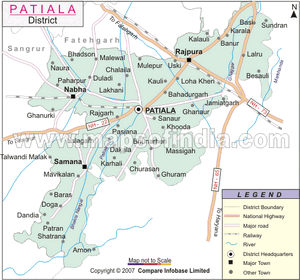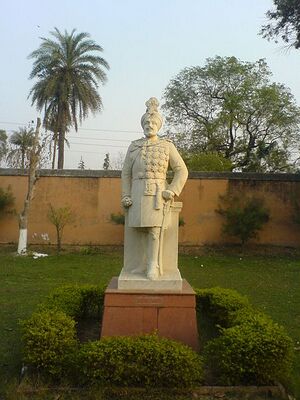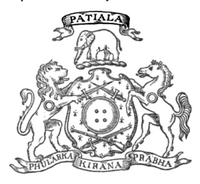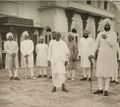Patiala



Patiala (Hindi:पटियाला, Punjabi: ਪਟਿਆਲਾ) is a city in the Punjab state of India. Patiala district had been a famous princely state in the Punjab.
Variants
- Patiala पटियाला, पंजाब, (AS, p.521)
- Pat-Ala (पट-आला)
- Ala Ki Patti (आला की पट्टी) (AS, p.521)
- Patti Ala (पट्टी आला) (AS, p.521)
Origin
Patiala gets name after Baba Ala Singh, the Sidhu Jat founder of Patiala state. It was earlier known as Pat-Ala (पट-आला) which changed to Patiala over a period of time.[1]
Location
Forming the south-eastern part of the state, it lies between 29°49’ and 30°47’ north latitude, 75°58’ and 76°54' east longitude.
Maharajas of Patiala
The first Maharaja of Patiala was Baba Ala Singh (1695–1765), who was granted the title by Ahmed Shah Abdali of Afghanistan in 1764.
The Maharajas of Patiala were awarded 17 gun salutes.
Following is the list of Maharajas of Patiala in order of their accession to the throne:
- Raja Ala Singh (1695–1765)
- Maharaja Amar Singh (b. 1747-d.1781)
- Maharaja Sahib Singh (b.1774-d.26 March 1813)
- Maharaja Karam Singh (r.30 June 1813- 23 Dec.1845)
- Maharaja Narendra Singh (r.18 January 1846-13 Nov.1858)
- Maharaja Mahendra Singh (b.16 Sept.1852, r.29 Jan.1863-1875 )
- Maharaja Rajinder Singh (25 May 1872-8 November 1900)
- Maharaja Bhupinder Singh (12 October, 1891 –23 March 1938)
- Maharaja Yadavindra Singh (January 17, 1913-June 17, 1974)
- Maharaja Amarinder Singh (born March 11, 1942) (Though the Privy purses, special privileges like gun salute and the titles of the Princely states' rulers were abolished in 1970 by the Government of India yet the erstwhile rulers continue to use the titles nominally as past practice)
Tahsils in Patiala district
Villages in Patiala Tahsil
Dulbha, Abdulpur, Ahru Kalan, Ahru Khurd, Akalgarh, Akbarpur Afghana, Akbarpur Urf Murad Majra, Akot, Alampur, Alipur Jattan, Alipur Sikhan, Alipur Wazir Sahib, Amam Nagar Urf Aliwala, Amampura, Arnauli, Asarpur, Asay Majra, Ashabpur, Asmanpur, Aujhan, Badla, Badli, Bahadurpur Fakiran, Bahadurpur Miranwala, Bahadurpur Namakgiran, Balamgarh, Balan, Balaspur, Balbhehra, Balipur, Bangran, Baran, Barkatpur, Barsat, Bathoi Kalan, Bathoi Khurd, Batta, Bazidpur, Behal, Behru, Bhagwanpur Jattan, Bhambuan, Bhankhar, Bhanra, Bhanri, Bhasmara, Bhat Heri, Bhathlan, Bhatian, Bhedpura, Bhunder Heri, Bibipur, Bibipur, Binjjal, Bir Bahadurgarh, Bir Kauli, Bir Kheri Gujran, Bir Kule Majra, Bir Moti Bagh, Bir Sarkar, Bishan Nagar, Bishangarh, Bishanpura Chhana, Bivipur Khurd, Boharpur, Bolar Kalan, Bolari, Bosar Kalan, Bosar Khurd, Budhanpur, Budhanpur, Budhmore, Bure Majra, Chalela, Chamarheri, Chaprahar, Chaura, Chirwa, Chirwi, Chohat, Chuharpur Jattan, Chuharpur Kalalan, Chuharpur Marasian, Churason, Chutehra, Dadhera, Dadherian, Dakala, Dalanpur, Dandoa, Daraula, Darauli, Daulatpur, Daulatpur, Daun Kalan, Daun Khurd, Dayagarh, Dealwal, Devi Nagar, Devinagar Hira Singhwala, Devinagar Urf Sawaesinghwala, Dhablan, Dhagrauli, Dhakarba, Dhamo Majra, Dhanauri, Dhandian, Dharam Heri, Dharamgarh Urf Kathgarh, Dharamkot, Dhareri Jattan, Dilawarpur, Doghat, Dudhan Gujran, Dudhan Sadhan, Dudhar, Durd, Falauli, Faridpur, Faridpur, Farm Bahadurgarh, Fatehpur, Fatehpur Jattan, Fatehpur Rajputan, Gagraula, Gagrauli, Gajju Majra, Ganaur, Ganeshpur, Gaunspura, Ghalori, Ghiora, Ghuram, Gobindpur Urf Saniar Heri, Guthmara, Haji Majra, Hajipur, Hamayunpur, Harana, Hardaspur, Hari Nagar Urf Kherki, Harigarh, Hashampur, Hassanpur Kamboan, Hassanpur Prohtan, Hira Garh, Hirdapur, Hussainpur Jolla, Hussainpur Urf Meharban Aliwala, Ibrahimpur, Inderpura, Isher Heri, Jafar Nagar Urf Sadiwal, Jahlan, Jalal Khera, Jalalpur, Jalbehra, Janherian, Jassowal, Jawalapur, Jhandi, Jodhpur, Jogipur, Julah Heri, Julkan, Kachhwa, Kachhwi, Kahna Heri, Kakapur, Kakrala, Kalar Bhaini, Kalwa, Kalyan, Kamalpur, Kapoori, Kar Heri, Karanpur, Karhali, Kartarpur, Kasiana, Katak Jeri, Kath Mathi, Kauli, Khaktan Kalan, Khaktan Khurd, Khalaspur, Khansa, Khansan, Kharabgarh, Khatauli, Khera Jattan, Kheri Barna, Kheri Gorian, Kheri Gujran, Kheri Malan, Kheri Manian, Kheri Musalmani, Kheri Raju Singh, Kheri Ranwan, Khudda, Khusropur, Kishangarh, Kishanpur, Kishanpur urf Bakhshiwala, Kooka, Kotla Gehru, Kule Majra, Lachkani, Lagroi, Lalina, Laluchhi, Lang, Lehla Jagir, Maddo Majra, Magar, Mahewan, Mahru, Main, Majal Kalan, Majal Khurd, Majra Kalan, Majrakhurd, Majri Akalian, Makhmailpur, Malakpur Kamboan, Malikpur Jattan, Malo Majra, Manak Dehar, Mandi, Maqboolpur Bhaini, Mardan Heri, Masingan, Mavi Sapan, Mehandipur, Mehargarh Batti, Mehaun, Mehmadpur, Mehmoodpur Jattan, Mehmudpur, Mehmudpur Araian, Mehmudpur Jattan, Mehmudpur Rurki, Mehtabgarh, Mirjapur, Mithu Majra, Mohalgarh, Moran, Muhabbatpur, Multanpur, Mundkhera, Muradpur, Nagar, Nain Kalan, Nain khurd, Nanansu, Nandpur Kesho, Naraingarh Basawa Singhwala, Naraingarh Urf Majra, Nasirpur, Naurangwala Urf Naraingarh, Niamatpur, Nijampur, Nogawan, Noor Kherian, Noorpur Faranswala, Paharipur, Paharpur, Palakha, Panaudian, Panjeta, Panjola, Parour, Partapgarh, Pasiana, Patiala (M Corp.), Phagan Majara, Pipal Kheri Urf Mahadevpur, Poonian Jattan, Punian Khanan, Pur, Raipur, Rajgarh, Rajpur, Rakhra, Ram Nagar, Ram Nagar Alias Bakshiwala, Ramgarh, Ranbirpura, Randhawa, Rasulpur Jaura, Rasulpur Urf dundi Majra, Rathian, Ratta Khera, Rauni, Rawas Brahmanan, Rith Kheri, Rohar Jagir, Rongla, Roshanpur, Rourgarh, Rurki Budhsingh, Rurki Kasba (CT), Sadarpur, Sadhpur Viran, Safera, Sahib Nagar Urf Theri, Sahnipur Urf Tanda, Saifdipur, Salempur Balian, Salempur Brahmana, Salempur Jattan, Sampurangarh, Sanaur (M Cl), Saniar Heri, Sarkara, Sarustigarh, Sasi Brahmanan, Sassa Gujran, Sehnserwal, Seuna, Shadipur, Shadipur, Shahbazpur, Shankerpur, Sheikhpur Jagir, Sheikhupur, Shekhpura (CT), Shekhupura, Sher Majra, Sidhuwal Sirkapra, Smashpur, Sular, Sultanpur, Surmastpur Urf Jalalabad, Tajalpur, Tarain, Taraura Khurd, Taraurakalan, Tasulpur, Tauran, Teja, Thakargarh, Tiwana, Tulewal, Ucha Gaon, Udepur Urf Diwanwala, Uppali, Zaffarpur,
पटियाला
विजयेन्द्र कुमार माथुर[2] ने लेख किया है ...पटियाला, पंजाब, (AS, p.521): पटियाला नाम इसके आलासिंह नाम के सरदार की पट्टी (जागीर) में स्थित होने के कारण हुआ था. पटियाला, जींद और नाभा- ये तीन स्थान फूल सिंह नामक एक सरदार को अंग्रेजों की सहायता करने के बदले में दिए गए थे. आला सिंह इसी फूल सिंह का पुत्र था. फूल सिंह ने मृत्यु से पहले पटियाला को आला सिंह की जागीर में नियत कर दिया था. आला की पट्टी या पट्टी आला से बिगड़ कर ही पटियाला नाम बन गया. यहां के पुराने स्मारकों में गुलाबी बाग प्रसिद्ध है. पहले पटियाला नरेश यहीं रहते थे. उनकी 360 रानियों के महल भी इसी बाग के अंदर बने थे. यहां एक चिड़ियाघर भी बनाया गया था जिसके जानवरों के शोरगुल से तंग होकर रानियों ने मोती बाग में एक नया महल बनवाया. मोती महल के राजप्रसाद की इमारत बड़ी भव्य तथा सुसज्जित है. पटियाला सिखधर्म का एक केंद्र माना जाता है. गुरु गोविंद सिंह की एक कृपाण, जो उन्होंने सूरत के एक मुसलमान को दी थी, यहां के संग्रहालय में सुरक्षित है. हिंदुओं का काली मंदिर भी पटियाला का प्रसिद्ध स्थान है. इस मंदिर की विशालता और साज-सज्जा की दृष्टि से इसे कोलकाता के काली मंदिर के समकक्ष ही समझा जाता है.
पटियाला शहर और ज़िला, पश्चिमोत्तर भारत के दक्षिण-पूर्व पंजाब राज्य में है। 1763 में इसकी स्थापना पटियाला रियासत की राजधानी के रूप में हुई थी। 1948 में इस रियासत का भारतीय संघ में विलय हो जाने के बाद यह पटियाला तथा पूर्वी पंजाब के राज्यों के संघ (पेप्सू) की राजधानी बना और 1966 में पंजाब राज्य में पेप्सू के विलय तक इसकी यही स्थिति बनी रही। आज़ादी के पहले और बाद में पटियाला राजनीतिक, प्रशासनिक और सांस्कृतिक दृष्टि से काफ़ी महत्त्वपूर्ण रहा है। पंजाब की सभी रियासतों में पटियाला सबसे महत्त्वपूर्ण था, वर्तमान ज़िला उसी क्षेत्र का एक हिस्सा है।[3]
सिद्धू - बराड़ जाटवंश
दलीप सिंह अहलावत [4] के अनुसार सिद्धू - बराड़ जाटवंश (गोत्र) चन्द्रवंशी मालव या मल्ल जाटवंश के शाखा गोत्र हैं। मालव जाटों का शक्तिशाली राज्य रामायणकाल में था और महाभारतकाल में इस वंश के जाटों के अलग-अलग दो राज्य, उत्तरी भारत में मल्लराष्ट्र तथा दक्षिण में मल्लदेश थे। सिकन्दर के आक्रमण के समय पंजाब में इनकी विशेष शक्ति थी। मध्यभारत में अवन्ति प्रदेश पर इन जाटों का राज्य होने के कारण उस प्रदेश का नाम मालवा पड़ा। इसी तरह पंजाब में मालव जाटों के नाम पर भटिण्डा, फरीदकोट, फिरोजपुर, लुधियाना आदि के बीच के प्रदेश का नाम मालवा पड़ा। (देखो, तृतीय अध्याय, मल्ल या मालव, प्रकरण)।
जब सातवीं शताब्दी में भारतवर्ष में राजपूत संघ बना तब मालव या मलोई गोत्र के जाटों के भटिण्डा में भट्टी राजपूतों से भयंकर युद्ध हुए। उनको पराजित करके इन जाटों ने वहां पर अपना अधिकार किया। इसी वंश के राव सिद्ध भटिण्डा नामक भूमि पर शासन करते-करते मध्य भारत के सागर जिले में आक्रान्ता होकर पहुंचे। इन्होंने वहां बहमनीवंश के फिरोजखां मुस्लिम शासक को ठीक समय पर सहायता करके अपना साथी बना लिया था जिसका कृतज्ञतापूर्वक उल्लेख शमशुद्दीन बहमनी ने किया है। इस लेखक ने राव सिद्ध को सागर का शासनकर्त्ता सिद्ध किया है। राव सिद्ध मालव गोत्र के जाट थे तथा राव उनकी उपाधि थी। इनके छः पुत्रों से पंजाब के असंख्य सिद्धवंशज जाटों का उल्लेख मिलता है। राव सिद्ध अपने ईश्वर विश्वास और शान्तिप्रियता के लिए विख्यात माने जाते हैं। राव सिद्ध से चलने वाला वंश ‘सिद्धू’ और उनकी आठवीं पीढ़ी में होने वाले सिद्धू जाट गोत्री राव बराड़ से ‘बराड़’ नाम पर इन लोगों की प्रसिद्धि हुई। राव बराड़ के बड़े पुत्र राव दुल या ढुल बराड़ के वंशजों ने फरीदकोट और राव बराड़ के दूसरे पुत्र राव पौड़ के वंशजों ने पटियाला, जींद, नाभा नामक राज्यों की स्थापना की। जब पंजाब पर मिसलों का शासन हुआ तब राव पौड़ के वंश में राव फूल के नाम पर इस वंश समुदाय को ‘फुलकिया’ नाम से प्रसिद्ध किया गया। पटियाला, जींद, नाभा रियासतें भी फुलकिया राज्य कहलाईं। बाबा आला सिंह संस्थापक राज्य पटियाला इस वंश में अत्यन्त प्रतापी महापुरुष हुए। राव फूल के छः पुत्र थे जिनके नाम ये हैं - 1. तिलोक 2. रामा 3. रुधू 4. झण्डू 5. चुनू 6. तखतमल। इनके वंशजों ने अनेक राज्य पंजाब में स्थापित किए।
जाट वीरों का इतिहास: दलीप सिंह अहलावत, पृष्ठान्त-774
फुलकिया से सम्बन्धित कैथल और अरनौली राज्य थे। इनके अतिरिक्त भदौड़, झुनवा, अटारी आदि छोटी-छोटी रियासतें भी सिद्धू जाटों की थीं। यही वंश पंजाब में सर्वाधिक प्रतापी है और सम्पूर्णतया धर्म से सिक्ख है।
राव सिद्धू के पुत्र राव भूर बड़े साहसी वीर योद्धा थे। अपने क्षेत्र के भट्टी राजपूतों से इसने कई युद्ध किए। इसी तरह से राव भूर से सातवीं पीढ़ी तक के इस सिद्धूवंश के वीर जाटों ने भट्टी राजपूतों से अनेक युद्ध किए। भट्टी राजपूत नहीं चाहते थे कि हमारे रहते यहां कोई जाट राज्य जमे या जाट हमसे अधिक प्रभावशाली बनकर रहें किन्तु राव सिद्धू की आठवीं पीढ़ी में सिद्धू गोत्र का जाट राव बराड़ इतना लड़ाकू शूरवीर, सौभाग्यशाली योद्धा सिद्ध हुआ कि उसने अपनी विजयों द्वारा राज्यलक्ष्मी को अपनी परम्परा में स्थिर होने का सुयश प्राप्त किया। यहां तक कि फक्करसर, कोट लद्दू और लहड़ी नामक स्थानों पर विजय प्राप्त करने पर तो यह दूर-दूर तक प्रख्यात हो गया। राव बराड़ के नाम पर सिद्धूवंशज बराड़वंशी कहलाने लगे। आजकल के सिद्धू जाट अपने को बराड़वंशी कहलाने में गौरव अनुभव करते हैं। इस वीर योद्धा राव बराड़ के दो पुत्र थे। बड़े का नाम राव दुल (ढुल) और छोटे का नाम राव पौड़ था।
इन दोनों की वंशपरम्परा में पंजाब में निम्न राज्य स्थापित किए ।
History


Patiala was an important Jat state in Punjab. Its area was 5932 sq. mile and annual income Rs 1,63,00,000/-. [5]The early history of the founders of Patiala state is more myth and mystery than reality, the rulers of the erstwhile states of Patiala, Nabha and Jind trace their ancestry to Jat sardar Chota Phul. Apparently the appellation of dynasty "Phulkian" is derived from their common founder.
One of sons of Phul Chota, Ram Singh was baptized and blessed by Guru Gobind Singh. His son Ala Singh assumed the leadership in 1714 when Banda Bahadur was engaged in the fierce battle against the Mughals. A man with vision and courage, Ala Singh carved out an independent principality from a petty Zamindari of 30 villages. Under his successors, it expanded into a large state, touching the Shivaliks in north, Rajasthan in the south and upper courses of the Yamuna and Sutlej rivers while confronting the most trying and challenging circumstances.
In the middle of the eighteenth century, Baba Ala Singh, unlike many of his contemporaries, displayed tremendous shrewdness in dealing with the Mughals, Afghans and Marathas and successfully established a state which he had started building up from its nucleus Barnala.
In 1763 Baba Ala Singh laid the foundation of the Patiala fort known as Qila Mubarak, around which the present city of Patiala developed. After the Third Battle of Panipat in 1761 in which the Marathas were defeated, the writ of the Afghans prevailed through out Punjab. It is at this stage that the rulers of Patiala began to acquire ensigns of royalty. Ahmad Shah Abdali bestowed upon Ala Singh furm and banner, and the title of Maharaja of Patiala. After his death, his grandson Amar Singh succeeded and received the title of Raja-I-Rajaan. He was also allowed to strike coins.

After forty years of ceaseless struggle with the Mughals, Afghans and Marathas the borders of the Patiala state witnessed the blazing trails of Ranjit Singh in the north and of the British in the east. Bestowed with the grit and instinct of survival, making the right choice at the right time the Raja of Patiala entered into a treaty with the British against Ranjit Singh in 1808, thus becoming collaborators in the British Empire building process of the British in Indian sub-continent. The British treated the rulers of Patiala, such as Karam Singh, Narinder Singh, Mahendra Singh, Rajinder Singh, Bhupinder Singh and Yadvindra Singh with respect and dignity.
Maharaja Bhupinder Singh (Reign - 1900 to 1938) gave Patiala a prominent place on the political map of India and in the field of international sports. This included his dog kennels and he and the Maharaja of Jind were equally interested in a range of dog breeds. His son Yadvindra Singh was among those Indian princes who readily came forward to sign the Instrument of Accession, thus facilitating the process of national integration. In recognition of his services, he was appointed the Rajpramukh of the newly established state of Patiala and East Punjab States Union (PEPSU), from its founding in 1948 until its merger with Punjab in 1956. The downtown area of Patiala is Adalat Bazaar, which means 'the court corridor', because this was used as the administrative building by one of the caretakers, before the King had reached the age of majority.
Moti Bagh Palace Patiala

Moti Bagh Palace , Patiala : Moti Bagh Palace Started during the reign of Sidhu Jat Ruler Maharaja Narinder Singh and was completed under Maharaja Bhupinder Singh in the early 20th century. The Old Moti Bagh Palace now houses the National Institute for Sports. The facade has Rajasthan-style jharokas and chhatris, and the palace is set in a beautiful garden with terraces, water channels and a Sheesh Mahal.
Source - Jat Kshatriya Culture
Sheesh Mahal Patiala

Sheesh Mahal is one of the most magnificent structures in Patiala. The palace was built by Maharaja Narinder Singh in the year 1845 to 1862 behind the main Moti Bagh Palace. The architecture of the palace is an amalgamation of both the Mughal and European styles. The palace was a residential palace which was made in a forest with an artificial lake, fountains, gardens, and a suspension bridge which is a replica of Laxman Jhula in Rishikesh. The fort is known for its spectacular works of art and architecture.
Source - Jat Kshatriya Culture
Jat clans in Patiala
Jat Sikh Clans and Their Population in Selective Districts of Punjab Handbooks [6] [7] [8] prepared by British military officers for the recruitment of Sikhs into the British Indian Army contain information on the location of Jat clans and their respective population in various districts of Punjab. Therefore, this section (basically based on these documents) presents various Jat clans and their respective population projected by B S Dhillon. [9]
Patiala (state during the British period) In 1911, 30 per cent of the Patiala state population was made of the Jats. Major Barstow [5], on page 110 wrote, "Patiala Jats mostly claim Rajput origin and appear to have migrated from Jaisalmer (in modern Indian state of Rajasthan south of Punjab) around the middle of the 16th century".
- Sidhu (138,000): This is the largest clan and the Royal family of the former Patiala state belonged to this very clan.
- Sarwara(30,000):Sarwara belt is in Patiala district.there are main 24 villages of this clain in Ghanaur sub tehsil.2 villages out of this belt is now in mohali district
- Chahil (64,500): This clan owns many villages around the town of Bhikkhi as well as it holds several scattered villages in the sub-districts of Fategarh, Narwana, Bhawanigarh, Amargarh.
- Dhaliwal (54,000): It appears that this clan has settled in this area around 12th or 13th century A.D. from Jaisalmer (in the modern Indian state of Rajasthan) and claims Rajput origin [5]. Dhaliwals are mainly to be found in the sub-districts of Bhatinda and Bhikhi and their important septs are Mani, Rureka, Ramana, Udi, and Dina.
- Mann (48,000): This clan has given their name to many villages for example, Manwala, Man Khera, and Man-sa.
- Dhillon (31,500): This clan claim its descent from "king Karn" and the Dhillons are mainly to be found in the sub-district of Govindgarh as well as in scattered villages of sub-districts Bhikhi and Fatehgarh.
- Gill (45,900): This clan is quite numerous in the sub-districts of Bhikhi and Rajpura and its sept "Jhala" holds 11 villages in the subdistrict called Sahibgarh.
- Dhindsa (7,950): This clan also claims its descent from "King Karn" and during the Mughal period in India, the Dhindsas migrated from the Sirsa area of the modern Indian Province of Haryana bordering Punjab. Dhindsas are mainly to be found in the subdistrict of Amargarh where they own many villages, also their presence is visible in the sub-districts of Rajpura, Patiala, and Ghanaur.
- Randhawa (6,960): This clan holds two villages in the sub-district of Sahibgarh and the village of Mimsa in the Sub-district Amargarh.
- Sarah or Sarai (19,800): This clan is mainly to be found in areas around Anahadgarh and Karmgarh and it claims to have founded the villages of Kalanwali in Sirsa and Kaleke near Dhanaula.
- Pawania (4,560): This clan claims to have migrated from the Hissar district of the modern Indian state of Haryana and owns 4 villages in the sub-district of Sunam.
- Ghumman (15,600): This clan owns 11 villages around Bhawanigarh and Ghumana in the Rajpura sub-district and one village in the Patiala sub-district.[10]
- Bains (3,012): This clan claims Tur Rajput origin and have migrated from the Delhi area. The clan holds many villages in the sub-district of Narwana as well as some in the Sub-districts of Sunam and Patiala.
- Mangat (5,400): This clan holds 6 villages in the sub-district of Sahibgarh.
- Sandhu (34,500): This clan claims to have migrated from the Amritsar area of the Punjab in the 16th century A.D. and holds villages in the sub-districts of Barnala, Bhatinda, Rajpura, Ghanaur, and Amargarh.
- Sekhon (10,500): This clan holds the villages of Bakshiwala (Sunam sub-district), Kaulgarh (Pail sub-district), Kanhgarh (Bhikkhi Sub-district), Kishangarh (Bhikkhi subdistrict) and Karmgarh (Anhadgarh sub-district).
- Mahil (2,169): This clan also claims its origin from the Tur Rajputs and came from the Delhi area. The clan owns four villages: Shahpuri Khurd and Kalan, Namol (all of these three in Sunam sub-district), and Khanpur (in Dhuri sub-district).
- Other Jat clans - Bandar (3,180), Bhainiwal (4,440), Bhangu (10,650), Bhullar (12,300), Dhanake (19,500), Dhandiwal (12,000), Gandhu (18,000), Grewal (10,680), Kailrauni (5,400),Mander (6,900), Sari (7,800), Saroe (22,800), Sohi (9,000), Tawana (9,600), Sarao (5,550), Sarware (5,400), Narani (4,650), Narwan (3,870), Punder (4,050), Punia (5,400), Samrao (3,900), Sanghare (3,600),Kharand (7,800), Jhund (4,050), Mandashar (5,550), Maur (3,300), Dullat (3,900), Gurne (3,900), Hinjha (7,200), Janjh(5,100), Janjhar (3,600), Jatana (4,200), Aulak (7,620), Awjle (4,l40), Bandechhe (3,540), Bhatthal (5,610), Biling (4,500), Birk (3,600), Bole (3,000), Chattha (4,800), Chimma (3,900), Chohan (5,400), Dallu (2,850), Dhanoe (3,300), Dhanor (4,500), Dhawe(4,800), Athwal (1,542), Autal (2,919), Bagar (1,800), Bachal (840), Baidwan (1,650), Bachta (1,110), Bajwa (2,820), Bandhel (2,250), Bansi (2,490), Basati (1,110), Banwaria (2,280), Batoe (1,890), Beri (2,010), Bhatti (1,410), Bhuttar (1,380), Boperae (4,80), Bore (1,980), Chandi (2,250), Chopare (1,050), Dangi (180), Doraian (750), Dehia (750), Dhandian (900), Dhandhana(1,650), Dhallian (900), Dholu (45), Dhota (2,400), Gadra (2,100), Gangore (3,900), Ganghas (1,860), Godara (2,190), Gosal (1,680), Hari (2,130), Her (2,640), Jakhar (1,200), Jaria (930), Jassar (2,610), Jawinda (1,500), Jhalli (1,590), Kahlon (210), Kandoe (270), Kang (2,850), Kankar (150), Khangas (810), Kharral (1,650), Khera (1,680), Khatre (1,650), Khire (2,130), Koharia (2,370), Lahar (1,590), Lamba (120), Lohchap (480), Mahvi (2,250), Maindal (3,450), Mandi (3,450), Nagre (1,710), Nain (1,050), Nalla (2,100), Nat (l,860), Ranwan (1,500), Raparia (45),Rathaul (1,950), Rathi (2,550), Rattiwal (1,440), Sahrawat (1,170), Salu (240), Sangwan (840), Sihumar (90), Siri (1,860), Sohal (1,800), Suraj (2,010), Tarka (390), Thind (1,800), Uppal (2,400), and Varaich (1,950).
Eminent personalities
- Patiala is home town of many eminent personalities like cricketers Navjot Singh Sidhu, Mohinder Amarnath, Reetinder Sodhi, Bollywood Stars Jimmy Shregill, Om Puri, Punjabi Singers Gurdas Mann & Harbhajan Mann, Jet Airways Chairman Naresh Goyal & above all Sq Ldr Rakesh Sharma, first and only Indian till date in space and so on.
- Rais Kiledar Sardar Dayal Singh Sekhon of Patiala (Kiledar under Patiala State).
Gallery
-
Portrait of Maharaja Amar Singh, Maharaja of Patiala, Date: ca. 1830. Collection: Brooklyn Museum
-
Yuvraj Sri Raninder Singh Sahib of Patiala
-
Rais Kiledar Sardar Dayal Singh Sekhon of Patiala
-
Maharaja Yadvendra Singh of Patiala with his son Maharaja Captain Amarinder Singh
-
Summer residence of the Patiala Royal family now run as The Palace Hotel at Chail
-
Raja Mrigendra Singh of Patiala with Rani Rani Harinder Kaur
-
Princess Rajeshwari Kumari of Patiala
-
Patiala Heritage Festival
-
Lt-Gen. H.H Maharaja Yadavindra Singh Of Patiala during his tour of the Italian Theater in October 1944. Source - Jat Kshatriya Culture
-
Major General S.B. Gurdial Singh Harika, was Chief Of The General Staff of Patiala & also the last Prime Minister of the State. General Harika was a big Jagirdar and is credited with training the famous Patiala Cavalry regiments. An accomplished horseman, it is said that the General knew every horse in the Patiala Stables by name. He was awarded with the prestigious Order Of British India, 1st class, and Indian Distinguished Service Medal. Dynasty- Sidhu Jat, Source - Jat Kshatriya Culture
-
Biba Rajwant Kaur, daughter of Sardar Kunda Singh Dhillon of Kotfateh. She was married to Raja Ram Narain Singh, brother of Maharaja Bhupinder Singh of Patiala. State:- Patiala (Sidhu), Estate:- Kotfateh (Dhillon), Source - Jat Kshatriya Culture
-
Maharaja Yadavindra Singh of Patiala, Maharaja Ranbir Singh Of Jind, Maharaja Jagatjit Singh of Kapurthala Maharaja Pratap Singh of Nabha, Maharaja Sir Harinder Singh Brar of Faridkot with Sardar Vallabhai Patel
-
The external Facade of the New Moti Bagh Palace, Patiala Private Residence of H.H.Maharaja Capt. Amarinder Singh, Chief Minister of Punjab and a Scion of the Patiala Royal Family. Source - Jat Kshatriya Culture
-
Maharaja Yadavindra Singh, Maharaja of Patiala gifted this self signed Photograph to his friend Khan bahadur Syed Abdullah Khan of Jansath, Source - Jat Kshatriya Culture
-
Lieutenant-General H.H.Maharaja Bhupinder Singh, Maharaja of Patiala, Dynasty - Sidhu, Source - Jat Kshatriya Culture
External links
References
- ↑ जाट इतिहास:ठाकुर देशराज, पृष्ठ-404
- ↑ Aitihasik Sthanavali by Vijayendra Kumar Mathur, p.521
- ↑ भारतकोश-पटियाला
- ↑ Jat History Dalip Singh Ahlawat/Chapter IX, pp. 774-775
- ↑ Dr Mahendra Singh Arya, Dharmpal Singh Dudi, Kishan Singh Faujdar & Vijendra Singh Narwar: Ādhunik Jat Itihas (The modern history of Jats), Agra 1998
- ↑ Barstow, A.E. (Major), The Sikhs: An Ethnology, reprinted by B.R. Publishing Corporation, Delhi, India, 1985, pp. 105-135.
- ↑ Bingley, A.H. (Captain), Handbooks for the Indian Army: Sikhs, compiled under the orders of the Government of India, Printed at the Government Central Printing Office, Simla, India, 1899, pp. 29-37.
- ↑ Falcon, R.W. (Captain), Handbook on Sikhs for the Use of Regimental Officers, Printed at the Pioneer Press, Allahabad, India, 1896, pp. 81-103.
- ↑ History and study of the Jats. By Professor B.S Dhillon. ISBN-10: 1895603021 or ISBN-13: 978-1895603026. p.123
- ↑ History and study of the Jats. By Professor B.S Dhillon. ISBN-10: 1895603021 or ISBN-13: 978-1895603026. p. 126



















